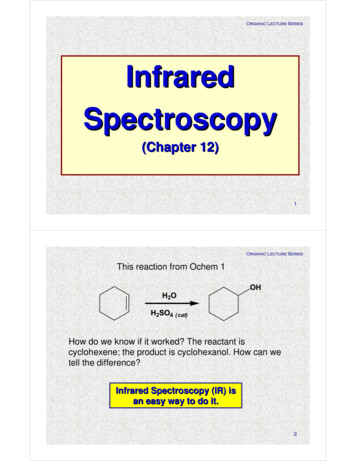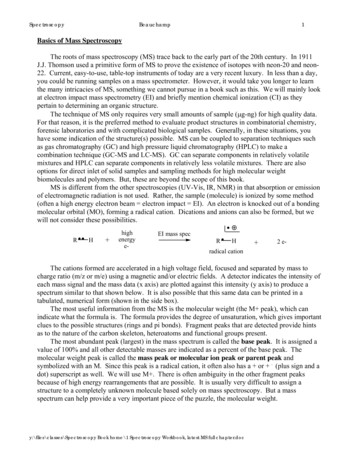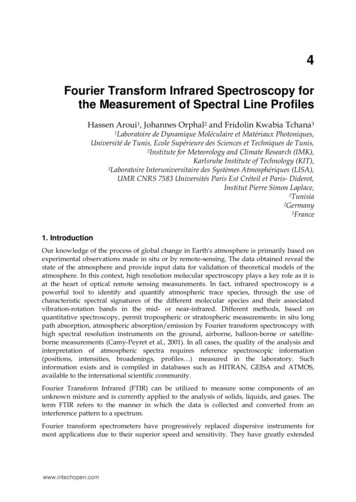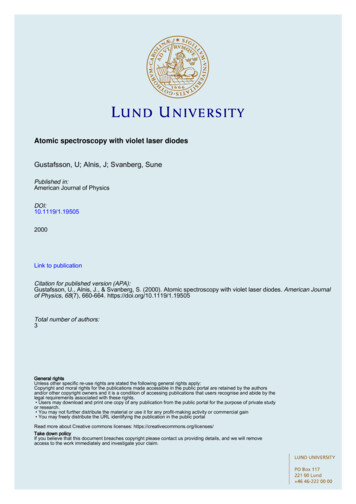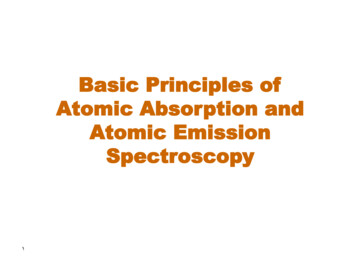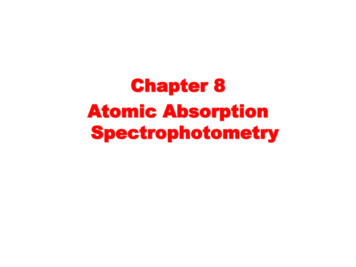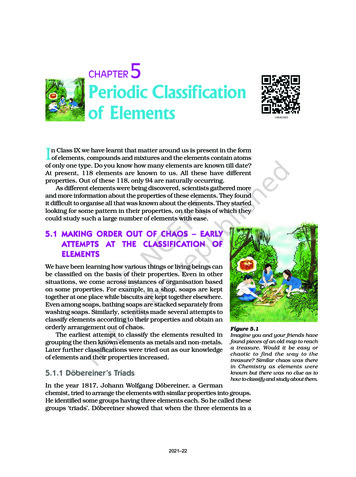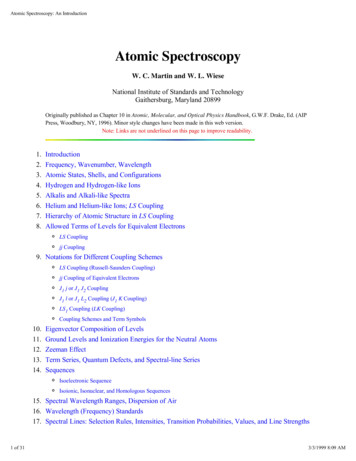
Transcription
Atomic Spectroscopy: An IntroductionAtomic SpectroscopyW. C. Martin and W. L. WieseNational Institute of Standards and TechnologyGaithersburg, Maryland 20899Originally published as Chapter 10 in Atomic, Molecular, and Optical Physics Handbook, G.W.F. Drake, Ed. (AIPPress, Woodbury, NY, 1996). Minor style changes have been made in this web version.Note: Links are not underlined on this page to improve readability.1.2.3.4.5.6.7.8.IntroductionFrequency, Wavenumber, WavelengthAtomic States, Shells, and ConfigurationsHydrogen and Hydrogen-like IonsAlkalis and Alkali-like SpectraHelium and Helium-like Ions; LS CouplingHierarchy of Atomic Structure in LS CouplingAllowed Terms of Levels for Equivalent ElectronsLS Couplingjj Coupling9. Notations for Different Coupling SchemesLS Coupling (Russell-Saunders Coupling)jj Coupling of Equivalent ElectronsJ1 j or J1 J2 CouplingJ1 l or J1 L2 Coupling (J1 K Coupling)LS1 Coupling (LK Coupling)Coupling Schemes and Term Symbols10.11.12.13.14.Eigenvector Composition of LevelsGround Levels and Ionization Energies for the Neutral AtomsZeeman EffectTerm Series, Quantum Defects, and Spectral-line SeriesSequencesIsoelectronic SequenceIsoionic, Isonuclear, and Homologous Sequences15. Spectral Wavelength Ranges, Dispersion of Air16. Wavelength (Frequency) Standards17. Spectral Lines: Selection Rules, Intensities, Transition Probabilities, Values, and Line Strengths1 of 313/3/1999 8:09 AM
Atomic Spectroscopy: An IntroductionEmission Intensities (Transition Probabilities)Absorption f valuesLine StrengthsRelationships between A, f, and SRelationships between Line and Multiplet ValuesRelative Strengths for Lines of Multiplets in LS Coupling18. Atomic Lifetimes19. Regularities and ScalingTransitions in Hydrogenic (One-Electron) SpeciesSystematic Trends and Regularities in Atoms and Ions with Two or More Electrons20. Spectral Line Shapes, Widths, and ShiftsDoppler BroadeningPressure Broadening21. Spectral Continuum RadiationHydrogenic SpeciesMany-Electron Systems22. Sources of Spectroscopic Data23. References1. INTRODUCTIONThis article outlines the main concepts of atomic structure, with some emphasis on terminology andnotation. Atomic radiation is discussed, in particular the wavelengths, intensities, and shapes of spectrallines, and a few remarks are made regarding continuous spectra. We include updated tabulations ofionization energies for the neutral atoms and transition probabilities for persistent lines of selected neutralatoms. Some sources of additional atomic spectroscopic data are mentioned.Experimental techniques and the details of atomic theoretical methods are not covered in this article;these and a number of other subjects pertinent to atomic spectroscopy are treated in one or more of atleast fifteen chapters in the volume Atomic, Molecular, and Optical Physics Handbook, G.W.F. Drake,Ed. (AIP Press, Woodbury, NY, 1996) and in references below.2. FREQUENCY, WAVENUMBER, WAVELENGTHThe photon energy due to an electron transition between an upper atomic level k (of energy Ek) and alower level i is2 of 313/3/1999 8:09 AM
Atomic Spectroscopy: An IntroductionE Ek - Ei h hc hc/ vac ,(1)where is the frequency, the wavenumber in vacuum, and vac the wavelength in vacuum. The mostaccurate spectroscopic measurements are determinations of transition frequencies, the unit being theHertz (1 Hz cycle/sec) or one of its multiples. A measurement of any one of the entities frequency,wavenumber, or wavelength (in vacuum) is an equally accurate determination of the others since thespeed of light is exactly defined. The most common wavelength units are the nanometer (nm), theÅngström (1 10-1 nm) and the micrometer (µm). The SI wavenumber unit is the inverse meter, but inpractice wavenumbers are usually expressed in inverse centimeters: 1 cm-1 102 m-1, equivalent to2.997 924 58 x104 MHz.In addition to frequency and wavenumber units, atomic energies are often expressed in electron volts(eV). One eV is the energy associated with each of the following quantities:2.417 988 4(7) x1014 Hz8 065.541 0(24) cm-11 239.842 44(37) nm11 604.45(10) K (kelvin)1.602 177 3(5) x10-19 J (joule)We note that the basic unit of temperature, the kelvin, is equivalent to about 0.7 cm-1, i.e., the value ofthe Boltzmann constant k expressed in wavenumber units per kelvin is 0.695 039(6) cm-1/K. One reasonfor citing this particular equivalency involving the internationally accepted symbol for the kelvin (K) [1] isto suggest that use of the letter K as a symbol for 1 cm-1 (1 kayser) should be discontinued.The unit of energy in the system of atomic units (a.u.) often used for theoretical calculations is thehartree, which is equal to 2 rydbergs. The rydberg for an atom having nuclear mass M is1 Ry RM M(M me)-1 R,(2)withR mec 2/(2h) 10 973 731.568 62(9) m-1 ,which is equivalent to 13.605 698(4) eV. The Rydberg constant Rnuclear mass.(3)is thus the limit value for infinite3. ATOMIC STATES, SHELLS, AND CONFIGURATIONSA one-electron atomic state is defined by the quantum numbers nlmlms or nljmj, with n and l representingthe principal quantum number and the orbital angular momentum quantum number, respectively. Theallowed values of n are the positive integers, and l 0, 1, ., n - 1. The quantum number j represents theangular momentum obtained by coupling the orbital and spin angular momenta of an electron, i.e.,j l s, so that j l 1/2. The magnetic quantum numbers ml, ms, and mj represent the projections ofthe corresponding angular momenta along a particular direction; thus, for example, ml -l, -l 1 . l and3 of 313/3/1999 8:09 AM
Atomic Spectroscopy: An Introductionms 1/2.The central field approximation for a many-electron atom leads to wave functions expressed in terms ofproducts of such one-electron states [2], [3]. Those electrons having the same principal quantum numbern belong to the shell for that number. Electrons having both the same n value and l value belong to asubshell, all electrons in a particular subshell being equivalent. The notation for a configuration of Nequivalent electrons is nlN, the superscript usually being omitted for N 1. A configuration of severalsubshells is written as nlNn l M . . The numerical values of l are replaced by letters in writing aconfiguration, according to the code s, p, d for l 0, 1, 2 and f, g, h . for l 3, 4, 5 ., the letter j beingomitted.The Pauli exclusion principle prohibits atomic states having two electrons with all four quantum numbersthe same. Thus the maximum number of equivalent electrons is 2(2l 1). A subshell having this numberof electrons is full, complete, or closed, and a subshell having a smaller number of electrons is unfilled,incomplete, or open. The 3p6 configuration thus represents a full subshell and 3s2 3p6 3d10 represents afull shell for n 3.The parity of a configuration is even or odd according to whether ili is even or odd, the sum being takenover all electrons (in practice only those in open subshells need be considered).4. HYDROGEN AND HYDROGEN-LIKE IONSThe quantum numbers n, l, and j are appropriate [4]. A particular level is denoted either by nlj or bynl 2LJ with L l and J j. The latter notation is somewhat redundant for one-electron spectra, but isuseful for consistency with more complex structures. The L values are written with the same letter codeused for l values, but with roman capital letters. The multiplicity of the L term is equal to2S 1 2s 1 2. Written as a superscript, this number expresses the doublet character of thestructure: each term for L 1 has two levels, with J L 1/2, respectively.The Coulomb interaction between the nucleus and the single electron is dominant, so that the largestenergy separations are associated with levels having different n. The hyperfine splitting of the 1H 1sground level [1420.405 751 766 7(10) MHz] results from the interaction of the proton and electronmagnetic moments and gives rise to the famous 21 cm line. The separations of the 2n - 1 excited levelshaving the same n are largely determined by relativistic contributions, including the spin-orbit interaction,with the result that each of the n - 1 pairs of levels having the same j value is almost degenerate; theseparation of the two levels in each pair is mainly due to relatively small Lamb shifts.5. ALKALIS AND ALKALI-LIKE SPECTRAIn the central field approximation there exists no angular-momentum coupling between a closed subshell4 of 313/3/1999 8:09 AM
Atomic Spectroscopy: An Introductionand an electron outside the subshell, since the net spin and orbital angular momenta of the subshell areboth zero. The nlj quantum numbers are, then, again appropriate for a single electron outside closedsubshells. However, the electrostatic interactions of this electron with the core electrons and with thenucleus yield a strong l-dependence of the energy levels [5]. The differing extent of "core penetration" forns and np electrons can in some cases, for example, give an energy difference comparable to or exceedingthe difference between the np and (n 1)p levels. The spin-orbit fine-structure separation between the nl(l 0) levels having j l - 1/2 and l 1/2, respectively, is relatively small.6. HELIUM AND HELIUM-LIKE IONS; LS COUPLINGThe energy structure of the normal 1snl configurations is dominated by the electron-nucleus andelectron-electron Coulomb contributions [4]. In helium and in helium-like ions of the lighter elements, theseparations of levels having the same n and having l s, p, or d are mainly determined by direct andexchange electrostatic interactions between the electrons - the spin-orbit, spin-other orbit, and otherrelativistic contributions are much smaller. This is the condition for LS coupling, in which:(a) The orbital angular momenta of the electrons are coupled to give a total orbital angularmomentum L ili.(b) The spins of the electrons are coupled to give a total spin S i si.The combination of a particular S value with a particular L value comprises a spectroscopic term, thenotation for which is 2S 1L. The quantum number 2S 1 is the multiplicity of the term. The S and Lvectors are coupled to obtain the total angular momentum, J S L, for a level of the term; the level isdenoted as 2S 1LJ.For 1snl configurations, L l and S 0 or 1, i.e., the terms are singlets (S 0) or triplets (S 1). Asexamples of the He I structure, the ionization energy (energy required to remove one of the 1s electronsin the 1s2 ground configuration) is 24.5874 eV, the 1s2s 3S - 1S separation is 0.7962 eV, the1s2p 3P - 1P separation is 0.2539 eV, and the 1s2p 3P 2 - 3P 0 fine-structure spread is only1.32 x 10-4 eV.7. HIERARCHY OF ATOMIC STRUCTURE IN LSCOUPLINGThe centrality of LS coupling in the analysis and theoretical interpretation of atomic spectra has led to theacceptance of notations and nomenclature well adapted to discussions of particular structures and spectra[2]. The main elements of the nomenclature are shown in the table below, most of the structural entitieshaving already been defined in the above discussions of simple spectra. The quantum numbers in the tablerepresent a full description for complex configurations, and the accepted names for transitions between5 of 313/3/1999 8:09 AM
Atomic Spectroscopy: An Introductionthe structural elements are also given.Atomic structural hierarchy in LS coupling and names for the groups of alltransitions between structural entities.QuantumnumbersaGroup of alltransitions(nili)NiTransition arrayPolyad(nili)Ni S1 L1 nl S L, S L .SupermultipletTerm(nili)Ni S LMultipletLevel(nili)Ni S L JLineState(nili)Ni S L J MLine ation may include several open subshells, as indicated by the isubscripts. The letter represents any additional quantum numbers, such asancestral terms, necessary to specify a particular term.As an example, the Ca I 3d4p 3D 2 level belongs to the 3D term which, in turn, belongs to the3d4p 3(P D F ) triplet triad. The 3d4p configuration also has a 1(P D F ) singlet triad. The 3d4sconfiguration has only monads, one 1D and one 3D. The 3d4s 3D2 - 3d4p 3D 3 line belongs to thecorresponding 3D - 3D triplet multiplet, and this multiplet belongs to the great Ca I 3d4s 3D 3d4p 3(P D F ) supermultiplet of three triplet multiplets discussed by Russell and Saunders in theirclassic paper on the alkaline-earth spectra [6]. The 3d4s - 3d4p transition array includes both the singletand triplet supermultiplets, as well as any (LS-forbidden) intercombination or intersystem lines arisingfrom transitions between levels of the singlet system and those of the triplet system. The order of the twoterms in the transitions as written above, with the lower-energy term on the left, is standard in atomicspectroscopy. Examples of notations for complex configurations are given in Notations for DifferentCoupling Schemes.8. ALLOWED TERMS OR LEVELS FOR EQUIVALENTELECTRONSLS CouplingThe allowed LS terms of a configuration consisting of two nonequivalent groups of electrons areobtained by coupling the S and L vectors of the groups in all possible ways, and the procedure maybe extended to any number of such groups. Thus the allowed terms for any configuration can be6 of 313/3/1999 8:09 AM
Atomic Spectroscopy: An Introductionobtained from a table of the allowed terms for groups of equivalent electrons.The configuration l N has more than one allowed term of certain LS types if l 1 and 2 N 4l(d 3 - d 7, f 3 - f 11, etc.). The recurring terms of a particular LS term type from d N and f Nconfigurations are assigned sequential index numbers in the tables of Nielson and Koster [7]; theindex numbers stand for additional numbers having group-theoretical significance that serve todifferentiate the recurring terms, except for a few terms of f 5 and f 9, f 6 and f 8, and f 7. Theseremaining terms, which occur only in pairs, are further labeled A or B to indicate Racah's separationof the two terms.The index numbers of Nielson and Koster are in practice the most frequently used labels for therecurring terms of f N configurations. Use of their index numbers for the recurring terms of d Nconfigurations has perhaps the disadvantage of substituting an arbitrary number for a quantumnumber (the seniority) that itself distinguishes the recurring terms in all cases. The actual value of theseniority number is rarely needed, however, and a consistent notation for the d N and f Nconfigurations is desirable. A table of the allowed LS terms of the l N electrons for l 3 is given inRef. [8], with all recurring terms having the index numbers of Nielson and Koster as a followingon-line integer. The theoretical group labels are also listed. Thus the d 3 2D term having seniority 3 isdesignated 2D2, instead of D, in this scheme; and the level having J 3/2 is designated 2D3/22.jj CouplingThe allowed J values for a group of N equivalent electrons having the same j value, ljN, are given inthe table below for j 1/2, 3/2, 5/2, and 7/2 (sufficient for l 3). The l47/2 group has two allowedlevels for each of the J values 2 and 4. The subscripts distinguishing the two levels in each case arethe seniority numbers [9].7 of 313/3/1999 8:09 AM
Atomic Spectroscopy: An IntroductionAllowed J values for ljN equivalent electrons (jjcoupling).ljNAllowed J valuesl1/21/l 2 1/20l3/2 and l 33/23/l 2 3/20, 2l 4 3/20l5/2 and l 55/25/l 2 5/2 and l 4 5/20, 2, 4l 3 5/23/l 6 5/20l7/2 and l 77/27/l 2 7/2 and l 6 7/20, 2, 4, 6l 3 7/2 and l 5 7/23/l40, 22, 42, 24, 44, 5, 6, 87/2l 8 7/22222,5/2,9/222,5/2,7/2,9/2,11/2,15/20The allowed levels of the configuration nl N may be obtained by dividing the electrons into sets oftwo groups, Q R N. The possible sets run from Q N - 2l (or zero if N 2l) up toQ N or Q 2l 2, whichever is smaller. The (degenerate) levels for a set with both Q and Rnonzero have wave functions defined by the quantum numbers ( J1, J2) J, with J1 and J2 derivingfrom the Q and R groups, respectively. The symbols and represent any additional quantumnumbers required to identify levels. The J values of the allowed levels for each ( J1, J2) subset areobtained by combining J1 and J2 in the usual way.9. NOTATIONS FOR DIFFERENT COUPLING SCHEMESThe following examples make clear the meaning of the different coupling-scheme notations. Not all the8 of 313/3/1999 8:09 AM
Atomic Spectroscopy: An Introductionconfigurations in the examples have been identified experimentally, and some of the examples of aparticular coupling scheme given for heuristic purposes may be physically inappropriate. Cowan [3]describes the physical conditions for the different coupling schemes and gives experimental examples.LS Coupling (Russell-Saunders Coupling)Some of the examples given below indicate notations bearing on the order of coupling of theelectrons.1.2.3.4.5.6.7.8.9.10.3d 7 4F7/23d 7(4F)4s4p(3P ) 6F 9/24f 7(8S )6s6p2(4P) 11P 53p 5(2P )3d 2(1G) 2F 7/24f 10(3K2)6s6p(1P ) 3L 64f 7(8S )5d (7D )6p 8F 13/24f 7(8S )5d (9D )6s (8D )7s 9D 54f 7(8S )5d (9D )6s6p(3P ) 11F84f 7(8S )5d 2(1G) (8G )6p 7F04f(2F ) 5d 2(1G)6s (2G) 1P 1In the second example, the seven 3d electrons couple to give a 4F term, and the 4s and 4p electronscouple to form the 3P term; the final 6F term is one of nine possible terms obtained by coupling the4F grandparent and 3P parent terms. The next three examples are similar to the second. Themeaning of the index number 2 following the 3K symbol in the fifth example is explained in thesection LS Coupling.The coupling in example 6 is appropriate if the interaction of the 5d and 4f electrons is sufficientlystronger than the 5d-6p interaction. The 7D parent term results from coupling the 5d electron to the8S grandparent, and the 6p electron is then coupled to the 7D parent to form the final 8F term. Aspace is inserted between the 5d electron and the 7D parent to emphasize that the latter is formedby coupling a term (8S ) listed to the left of the space. Example 7 illustrates a similar coupling ordercarried to a further stage; the 8D parent term results from the coupling of the 6s electron to the 9D grandparent.Example 8 is similar to examples 2 through 5, but in 8 the first of the two terms that couple to formthe final 11F term, i.e., the 9D term, is itself formed by the coupling of the 5d electron to the 8S core term. Example 9 shows an 8G parent term formed by coupling the 8S and 1G grandparentterms. A space is again used to emphasize that the following (8G ) term is formed by the coupling ofterms listed before the space.A different order of coupling is indicated in the final example, the 5d 2 1G term being coupled firstto the external 6s electron instead of directly to the 4f core electron. The 4f (2F ) core term is9 of 313/3/1999 8:09 AM
Atomic Spectroscopy: An Introductionisolated by a space to denote that it is coupled (to the 5d 2(1G)6s 2G term) only after the otherelectrons have been coupled. The notation in this particular case (with a single 4f electron) could besimplified by writing the 4f electron after the 2G term to which it is coupled. It appears moreimportant, however, to retain the convention of giving the core portion of the configuration first.The notations in examples 1 through 5 are in the form recommended by Russell, Shenstone, andTurner [10], and used in both the Atomic Energy States [11] and Atomic Energy Levels [8], [12]compilations. The spacings used in the remaining examples allow different orders of coupling of theelectrons to be indicated without the use of additional parentheses, brackets, etc.Some authors assign a short name to each (final) term, so that the configuration can be omitted intables of classified lines, etc. The most common scheme distinguishes the low terms of a particularSL type by the prefixes a, b, c, ., and the high terms by z, y, x, . [12].jj Coupling of Equivalent ElectronsThis scheme is used, for example, in relativistic calculations. The lower-case j indicates the angularmomentum of one electron (j l 1/2) or of each electron in an ljN group. Various ways ofindicating which of the two possible j values applies to such a group without writing the j-valuesubscript have been used by different authors; we give the j values explicitly in the examples below.We use the symbols Ji and j to represent total angular momenta.1. (6p 21/2)02. (6p 21/2 6p3/2) 3/23. (6p 21/2 6p 23/2)24. 4d 35/2 4d 23/2 (9/2, 2)11/2The relatively large spin-orbit interaction of the 6p electrons produces jj-coupling structures for the6p 2, 6p 3, and 6p 4 ground configurations of neutral Pb, Bi, and Po, respectively; the notations forthe ground levels of these atoms are given as the first three examples above. The configuration in thefirst example shows the notation for equivalent electrons having the same j value ljN, in this case two6p electrons each having j 1/2. A convenient notation for a particular level (J 0) of such a groupis also indicated. The second example extends this notation to the case of a 6p 3 configurationdivided into two groups according to the two possible j values. A similar notation is shown for the6p 4 level in the third example; this level might also be designated (6p -23/2)2, the negativesuperscript indicating the two 6p holes. The (J1, J2)J term and level notation shown on the right inthe fourth example is convenient because each of the two electron groups 4d 35/2 and 4d 23/2 hasmore than one allowed total Ji value. The assumed convention is that J1 applies to the group on theleft (J1 9/2 for the 4d 35/2 group) and J2 to that on the right.10 of 313/3/1999 8:09 AM
Atomic Spectroscopy: An IntroductionJ1 j or J1 J2 Coupling1. 3d 9(2D5/2)4p3/2 (5/2, 3/2) 32. 4f 11(2H 9/2 2)6s6p(3P 1) (9/2, 1)7/23. 4f 9(6H )5d (7H 8)6s6p(3P 0) (8,0)84. 4f 12(3H6) 5d(2D)6s6p(3P ) (4F 3/2) (6, 3/2) 13/25. 5f 4(5I4)6d3/2 (4,3/2)11/27s7p(1P 1) (11/2, 1) 9/26. 5f 47/25f 55/2 (8,5/2) 21/27p3/2 (21/2, 3/2)107. 5f 37/2 5f 35/2 (9/2, 9/2)97s7p(3P 2) (9,2) 7The first five examples all have core electrons in LS coupling, whereas jj coupling is indicated for the5f core electrons in the last two examples. Since the J1 and J2 values in the final (J1, J2) term havealready been given as subscripts in the configuration, the (J1, J2) term notations are redundant in allthese examples. Unless separation of the configuration and final term designations is desired, as insome data tables, one may obtain a more concise notation by simply enclosing the entireconfiguration in brackets and adding the final J value as a subscript. Thus, the level in the firstexample can be designated as [3d 9(2D5/2) 4p3/2] 3. If the configuration and coupling order areassumed to be known, still shorter designations may be used; for example, the fourth level abovemight then be given as [(3H6) (3P ) (4F 3/2)]13/2 or (3H6, 3P , 4F 3/2)13/2. Similar economies ofnotation are of course possible, and often useful, in all coupling schemes.J1l or J1L2 Coupling (J1K Coupling)1. 3p 5(2P 1/2)5g 2[9/2] 52. 4f 2(3H4)5g 2[3]5/23. 4f 13(2F 7/2)5d 2(1D) 1[7/2] 7/24. 4f 13(2F 5/2)5d6s(3D) 3[9/2] 11/2The final terms in the first two examples result from coupling a parent-level J1 to the orbital angularmomentum of a 5g electron to obtain a resultant K, the K value being enclosed in brackets. The spinof the external electron is then coupled with the K angular momentum to obtain a pair of J values,J K 1/2 (for K 0). The multiplicity (2) of such pair terms is usually omitted from the termsymbol, but other multiplicities occur in the more general J1L2 coupling (examples 3 and 4). The lasttwo examples are straightforward extensions of J1l coupling, with the L2 and S2 momenta of the"external"' term (1D and 3D in examples 3 and 4, respectively) replacing the l and s momenta of asingle external electron.LS1 Coupling (LK Coupling)11 of 313/3/1999 8:09 AM
Atomic Spectroscopy: An Introduction1. 3s 23p(2P )4f G 2[7/2]32. 3d 7(4P)4s4p(3P ) D 3[5/2] 7/2The orbital angular momentum of the core is coupled with the orbital angular momentum of theexternal electron(s) to give the total orbital angular momentum L. The letter symbol for the final Lvalue is listed with the configuration because this angular momentum is then coupled with the spin ofthe core (S1) to obtain the resultant K angular momentum of the final term (in brackets). Themultiplicity of the [K] term arises from the spin of the external electron(s).Coupling Schemes and Term SymbolsThe coupling schemes outlined above include those now most frequently used in calculations ofatomic structure [3]. Any term symbol gives the values of two angular momenta that may becoupled to give the total electronic angular momentum of a level (indicated by the J value). Forconfigurations of more than one unfilled subshell, the angular momenta involved in the final couplingderive from two groups of electrons (either group may consist of only one electron). These are oftenan inner group of coupled electrons and an outer group of coupled electrons, respectively. In anycase the quantum numbers for the two groups can be distinguished by subscripts 1 and 2, so thatquantum numbers represented by capital letters without subscripts are total quantum numbers forboth groups. Thus, the quantum numbers for the two vectors that couple to give the final J arerelated to the term symbol as follows:Coupling Quantum numbers for vectors TermSchemethat couple to give JSymbolLSL,S2S 1LJ1 J2J1, J2(J1, J2)K, S22S2 1[K]K, S22S2 1[K]J1 L2(LS1(K)K)The parity is indicated by appended degree symbols on odd parity terms.10. EIGENVECTOR COMPOSITION OF LEVELSThe wave functions of levels are often expressed as eigenvectors that are linear combinations of basisstates in one of the standard coupling schemes. Thus, the wave function ( J) for a level labeled J mightbe expressed in terms of normalized LS coupling basis states ( SLJ):12 of 313/3/1999 8:09 AM
Atomic Spectroscopy: An Introduction(4)The c( SLJ) are expansion coefficients, and(5)The squared expansion coefficients for the various SL terms in the composition of the J level areconveniently expressed as percentages, whose sum is 100%. Thus the percentage contributed by the pureRussell-Saunders state SLJ is equal to 100 x c( SLJ) 2. The notation for Russell-Saunders basis stateshas been used only for concreteness; the eigenvectors may be expressed in any coupling scheme, and thecoupling schemes may be different for different configurations included in a single calculation (withconfiguration interaction). "Intermediate coupling" conditions for a configuration are such thatcalculations in both LS and jj coupling yield some eigenvectors representing significant mixtures of basisstates.The largest percentage in the composition of a level is called the purity of the level in that couplingscheme. The coupling scheme (or combination of coupling schemes if more than one configuration isinvolved) that results in the largest average purity for all the levels in a calculation is usually best fornaming the levels. With regard to any particular calculation, one does well to remember that, as withother calculated quantities, the resulting eigenvectors depend on a specific theoretical model and aresubject to the inaccuracies of whatever approximations the model involves.Theoretical calculations of experimental energy level structures have yielded many eigenvectors havingsignificantly less than 50% purity in any coupling scheme. Since many of the corresponding levels havenevertheless been assigned names by spectroscopists, some caution is advisable in the acceptance of leveldesignations found in the literature.11. GROUND LEVELS AND IONIZATION ENERGIES FORTHE NEUTRAL ATOMSTable of Ground Levels and Ionization Energies for the Neutral AtomsWhen using the above table, be sure to use your "Back" button to return to this document.The ground-state electron configurations of elements heavier than neon are shortened in the table byusing rare-gas element symbols in brackets to represent the corresponding electrons. The ground levels ofall neutral atoms have reasonably meaningful LS-coupling names, the corresponding eigenvectorpercentages lying in the range from 55 % to 100 %. These names are listed in the table, except for Pa,U, and Np; the lowest few ground-configuration levels of these atoms comprise better 5f N(L1S1J1),6dj7s2 (J1 j) terms than LS-coupling terms. The relatively large spin-orbit interaction of the 6p electronsproduces jj-coupling structures for the (6p21/2)0, (6p21/26p3/2)o3/2, and (6p21/26p23/2)2 ground levels ofthe 6p2, 6p3, and 6p4 configurations of neutral Pb, Bi, and Po, respectively. As noted in the section jjCoupling of Equivalent Electrons, the jj-coupling names are more appropriate for these atoms than thealternative LS-coupling designations in the table.The ionization energies in the table are based on a recent survey of the literature [13]. The uncertainties13 of 313/3/1999 8:09 AM
Atomic Spectroscopy: An Introductionare mainly in the range from less than one to several units in the last decimal place, but a few of the valuesmay be in error by 20 or more units in the final place; i.e., the error of some of the two place values couldbe greater than 0.2 eV. Estimated uncertainties of the ionization energies are usually given in thereferences. Although no more than four decimal places are given, the accuracies of some of the betterknown values would, in eV units, be limited only by the uncertainty in the conversion factor,1.239 842 44(37) x 10-4 eV/cm-1.12. ZEEMAN EFFECTThe Zeeman effect for "weak" magnetic fields (the anomalous Zeeman effect) is of special interestbecause of the importance of Zeeman data in the analysis and theoretical interpretation of complexspectra. In a weak field, the J value remains a good quantum number although in general a level is splitinto magnetic subleve
3. Atomic States, Shells, and Configurations 4. Hydrogen and Hydrogen-like Ions 5. Alkalis and Alkali-like Spectra 6. Helium and Helium-like Ions; LS Coupling 7. Hierarchy of Atomic Structure in LS Coupling 8. Allowed Terms of Levels for Equivalent Electrons LS Coupling jj Coupling 9. Notations for Different Coupling Schemes
